Outside of the Giardini and Arsenale, there were 35 national pavilions and 19 collateral events spread around the Venice historic centre, Giudecca, San Servolo, and Forte Marghera. I focus on the few I got to see.
Glasstress exhibition on Murano Island
This was another highlight of my visit. I loved the old abandoned glass furnace as the space for this exhibition. I was not familiar with this collaborative exhibition which has been ongoing since 2009 by the initiative of the artists Adriano Berengo.

With regards to new works, many of the artists produced pieces which engage with pertinent environmental concerns and man’s relationship to nature. These include Bricolante by French – Argentine artist Pablo Reinoso, a life-size sculpture which references the wooden poles (‘bricole’ in the Venetian dialect) that line the channels of the city and its lagoon. Reinoso views these poles as a strong visual identifier of the city which, when translated into glass, echoes its fragility and the ecological threats it faces.
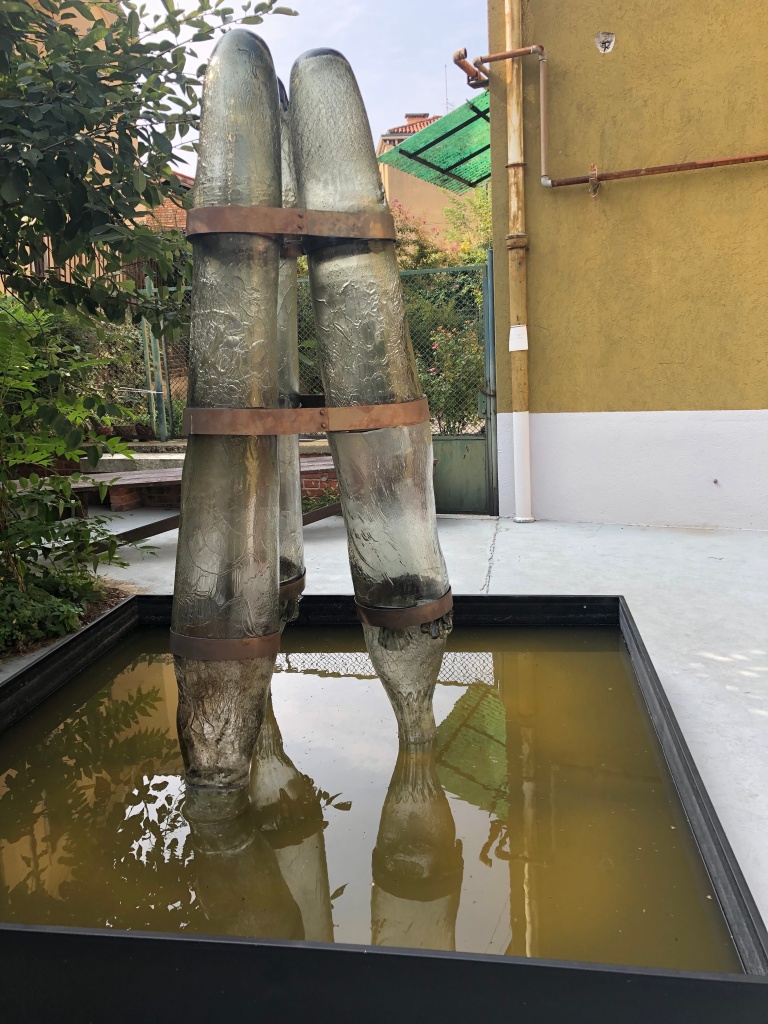
There are spiders and insects in a corner and pollution is addressed in the work of Brazilian sculptor Valeska Soares, titled Acqua Alta after the yearly flooding of the city, comprising a series of glass containers which refer to the pollution of manmade objects as well as to vessels used to carry water. Acqua Alta acknowledges water as a precious natural resource, susceptible to the forces of nature and highlights the tensions between excess and decay.
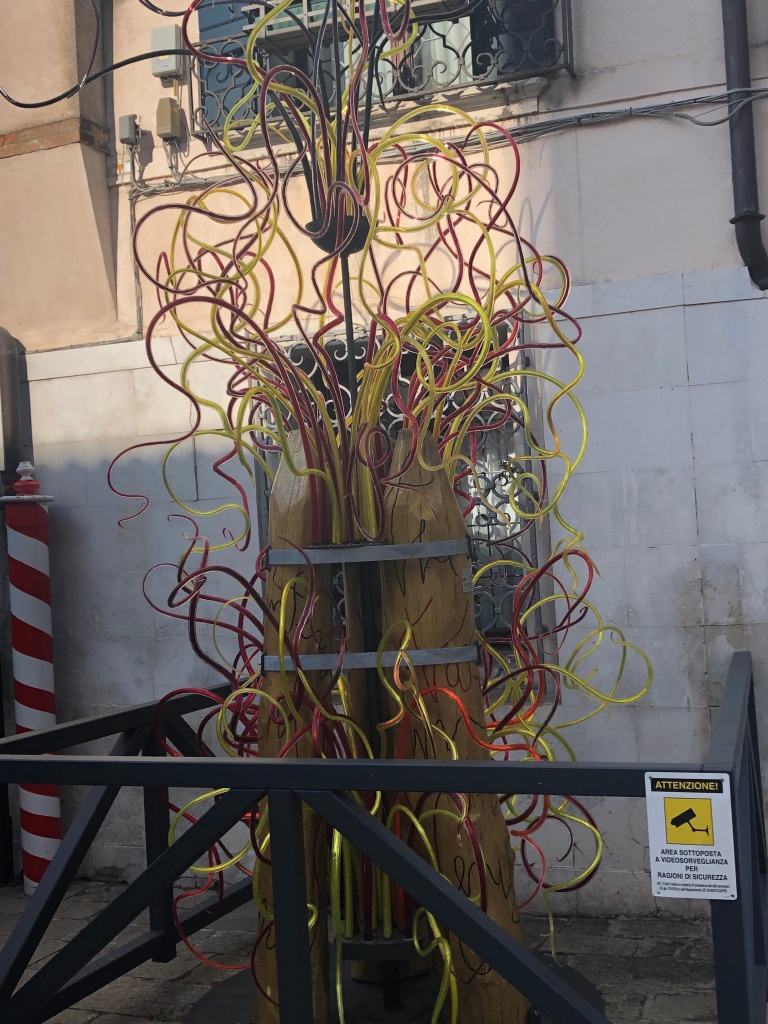
Above work is part of a poetry initiative to mark the occasion of the Venice Biennale. Ca’ Segredo is hosting a project by Marco Nereo Rotelli created in collaboration with the Massimiliano Schiavon Art Team, a forge based in Murano, whose spiritual fathers par excellence are four internationally-renowned writers from different continents, the poets Adonis (Syria), Yang Lian (China), Víctor Rodríguez Núñez (Cuba) and novelist Mark Axelrod (United States) The exhibition includes the installation of five “bricole fiore” (“flower dolphins”), each more than 5 metres high, four in Campo Santa Sofia and one on the Grand Canal. Two of these works were nearby where I stayed and I was lucky to walk into them – again the dolphins was intriguing and referring to this city build in water.
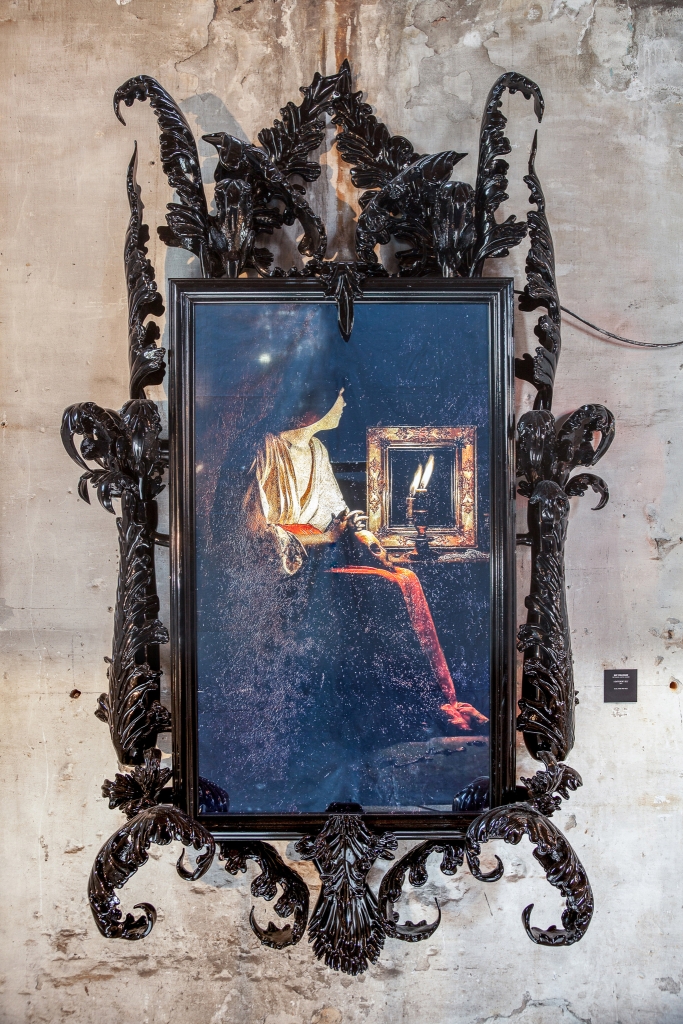
This British artist’s practice is inspired by art history, literature, and the Victorian era, associating all of them within today’s technological panorama, to create charged works that strive to rethink the relationship with tradition. His projects often reflect opposites: beauty and ugliness, fascinating and repellent, reality and artifice. Invisible Sisyphus by Dustin Yellin is and interesting collage of glass and acrylic – it hangs and one can move around it to see through the layers of glass.
Human Rights was addressed by Koen Vanmechelen and the series of work, called Collectvie Memory was spot on:
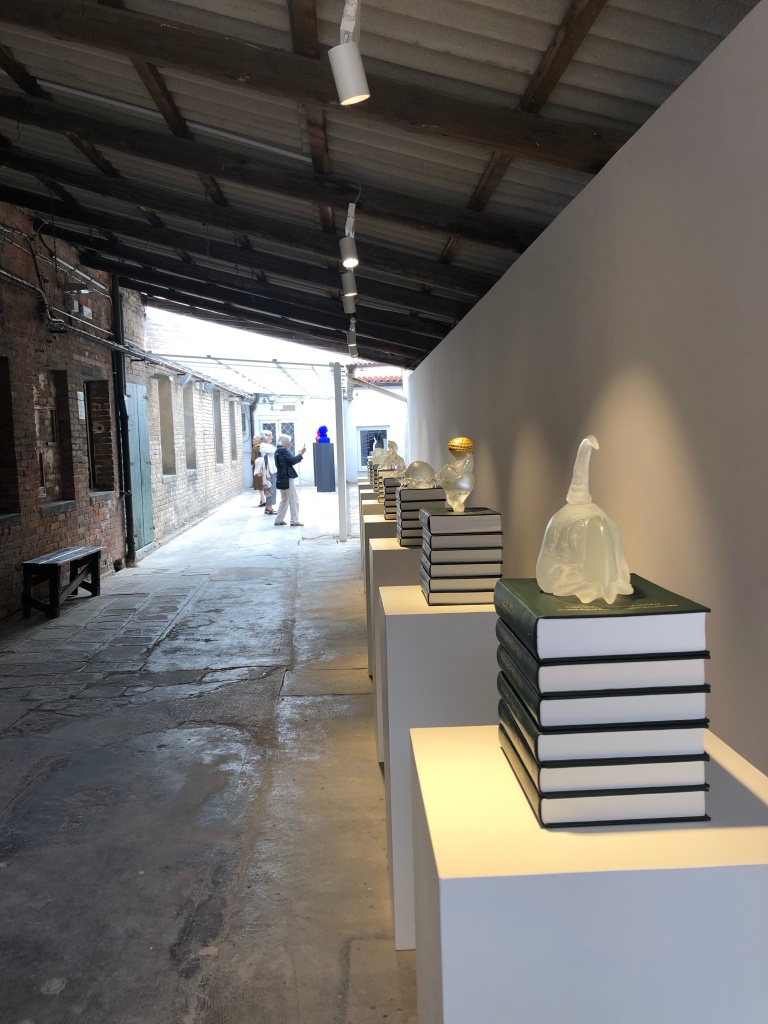
The Death of James Lee Byars at Chiesa di Santa Maria della Visitazione
The artist, Zad Moultaka in Dialogue created a golden void and uses his installation Vocal Shadows (2019), to advance on the work of Bryars, which is the surroundings of Byars’ chamber tomb that was originally created in 1994 by James Lee Byars himself while he was battling incurable cancer. We have 16 loudspeakers on pedestals from which a funeral choir is performing a requiem in the immediate surroundings of Byars’ chamber tomb. One cannot be but touched by the impact of death and absence and our human existence that is transient.

Gely Korzhev Back to Venice
This was a great exhibition of a Russian painter (1925 – 2012 in the second half of the 20th century. He was seen as a master of Socialist Realism. There were full -lenght nudes and portraits, smaller still lives and pieces that referred to the Second World War and the collapse of the Soviet Union, as well as a video installation. Again the opportunity to get real close up to the works was beneficial to see the paint strokes. The portrait works reminded me of that of Lucien Freud. Instead of the usual subject matter of the Socialist Realists, the tone of the exhibition is set by the nudes, painted later in the perestroika years and in the 2000s. Most of the works on the first floor also come from Korzhev’s latter years. In these paintings, trash, skeletons and fantasy creatures are surreally added to symbols of Soviet totalitarianism – the artist depicts himself as something akin to a martyr pondering the collapse of the old order.
Living Rocks A fragment of the universe
Nearby the installation of The Death of James Lee Byars we found this installation where sculpture meets moving image and sound as water floods the 30m long pool of water as exhibition space. From a pool emerges thrombolites that have been crafted by the artists Darling and Forwood. They employ the distinctive roots of an arid land of eucalyptus to create ‘living rocks’ or thrombolites. Surrounding the water are images in constant motion, the images are accompanied by String Quartet music performed by the Australian String Quartet. I enjoyed the scale of the work and the environmental issues it engaged with – our fragile ecosystem and sometimes detrimental conservation policies. Reading more:”Living Rocks was inspired by a lake containing rare, rock-like thrombolites, which are microbial structures that grow in shallow pools and release oxygen. These microbialites have colonised lake floors over the course of billions of years and supplied the first large quantities of oxygen to the Earth’s atmosphere. The mallee roots from the Eucalyptus plant are intricately arranged into an imposing geometric structures that reflect upon ideas of form, nature and evolution. The art of Darling and Forwood incorporates art and science in a daring multidisciplinary project that puts thrombolites at the centre of attention.” It shows the potential when multi disciplinaries work together.
Peggy Guggenheim Collection
This gallery was on my list and really has many treasured artworks of Cubism, Surrealism and Abstract Art. This includes sculptures as well as many artworks. Her connection with for example Marcel Duchamp, Robert Motherwell, Jackson Pollock and Mark Rothko came under my understanding when learning about Modernism and the art critique, Clement Greenberg. (UVC subject, my blog http://visualcultureblog519407.wordpress.com) Her influence on art after WW II in Europa as well as America was surely big as well as her legacy to art collecting. It was mind blowing to stand in front of a Picasso, a Duchamp and G Barque on one wall, and the list continues as you move through the halls. The gallery was very well attended. One could again come close to paintings and really see the works close up.
Personal Structures
The following was taken from the internet:
“European Cultural Centre presents ehibition Personal Structures at its three venues, Palazzo Mora, Palazzo Bembo and Giardini della Marinaressa, featuring a wide selection of works from artists, photographers, sculptors and universities from all over the world.
The exhibition presents internationally renowned artists together with emerging ones who have in common their dedication to contemporary art in the broadest sense but from various cultural backgrounds. The aim of each exhibitor is to illustrate an authentic and subjective reflection on the topics of “Time, Space, Existence”.”
I visited Palazzo Mora and will comment on my experience there, where I saw works by artists from the Islands of Guadeloupe, Seychelles and Kiribati – Mozambique pavilion was also here. I think the idea of putting individuality of the artist up front worked for me – many new and old names for me to get acquainted with. Amazing that the building is just as beautiful – like ceiling frescos! I learned of one to be a Tiepolo fresco! It is important to mention that this gallery was filled with work and that I left with that feeling of information overload – visually, but glad to have seen it! At least I have photos and will look for an online brochure to refer to.
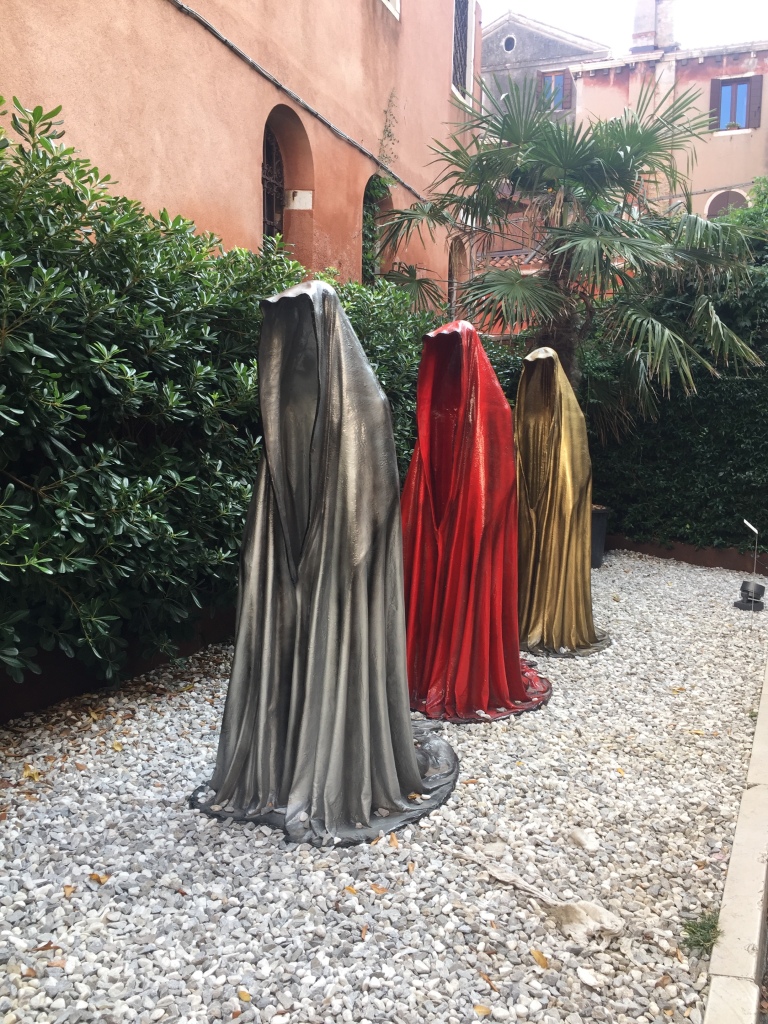
This work reminded me of a sitting figure (below) I found earlier in September in Prague. It was done by Anna Chromy, and called IL Commendatore, in Memory of W A Mozart’s Don Giovanni – in front of the Estates Theatre, where Mozart had his first performance of this opera. We did a private tour of this building, courtesy of Johan Conradie. ( link to the opera ) The Guardians of Time at Palazzo Mora are presented as life-size cloth objects in polyester resin for outdoor use lighted up from inside installed LED’s! My question is, can one link both works to immortality – or is this more the fact that we are being watched/monitored by the powers of authority – living in a surveillance state? I also share my son’s comment after I shared the statue with my family.
Below is the Mozart statue

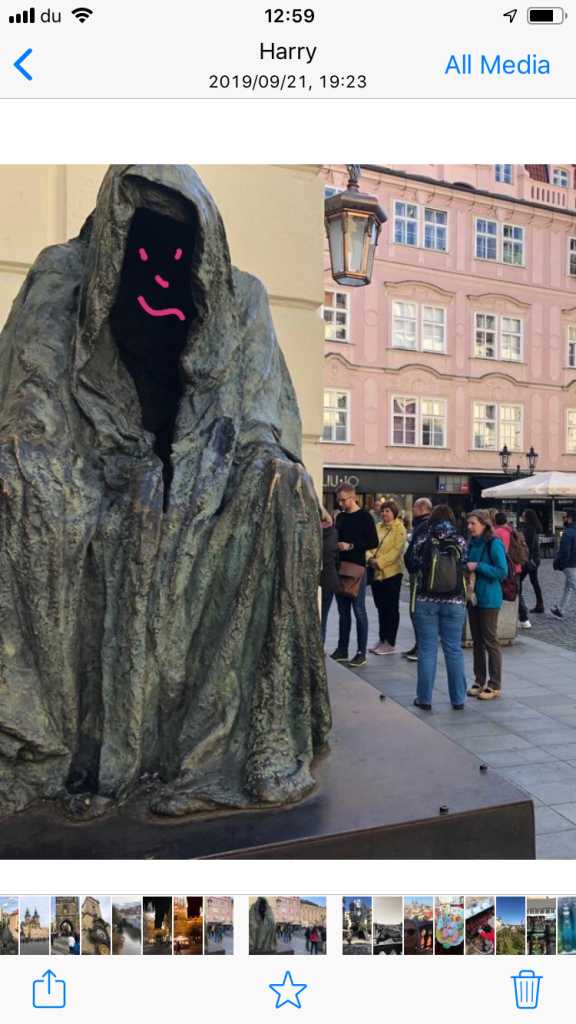
Below is the work of Ania Hobson – also work which reminds of Hopper? Interesting to read about her art making process: “It’s very rare that I would do preliminary sketches
before starting a painting – It’s more of an ‘in the moment’ thing for me, the quicker I set off the better the painting usually turns out..there is never that ‘perfect face’ to paint. I prefer to look at the figure as in how it’s composed in the space it is located in and how it interacts with the interior, an exploration of the sense of space, the
shapes together with the colour palettes.”
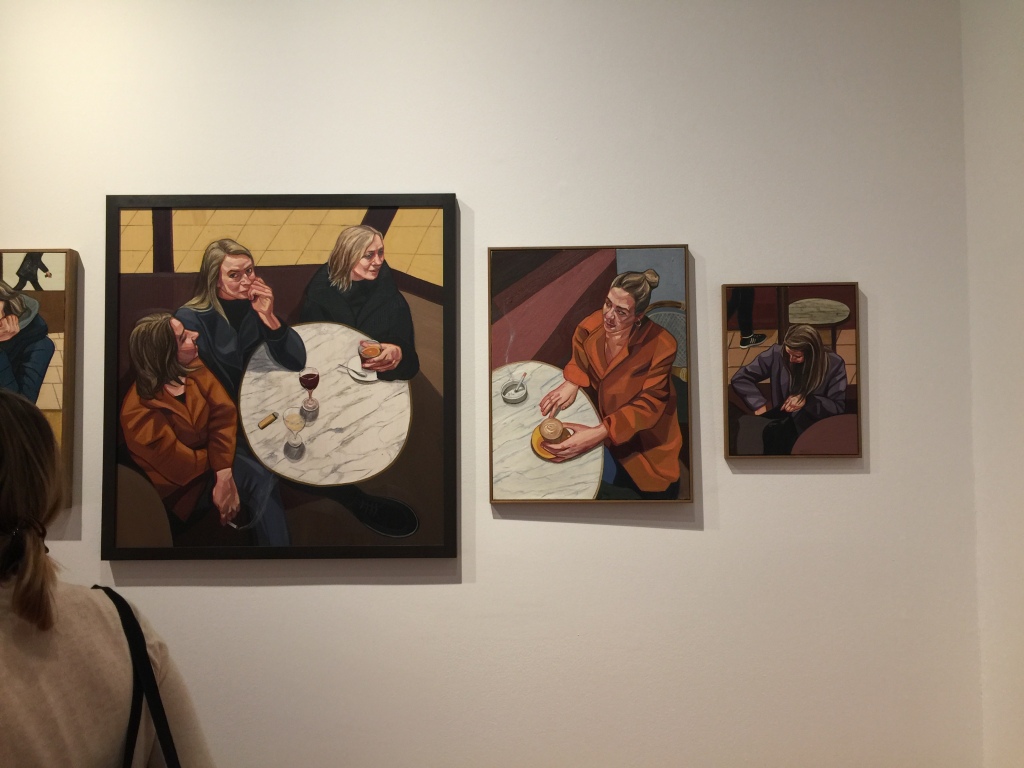
The photo diptych of Anne Kuhn of Heroïnes was a great subject – questions about why woman find it hard to assert themselves in total independence.
One great thing about visiting the art spaces is also the lovely views and architecture one can admire! This Sun Project captured Venice in a wonderful perspective! The installation are made of two main parts: A glass sphere filled with transparent fluid that converts into a magnifying glass. and then a double curved “screen” fixed in the focal point. When the sun is shining, the energy in the focal point will make a hole
or engrave marks in the “screen”.
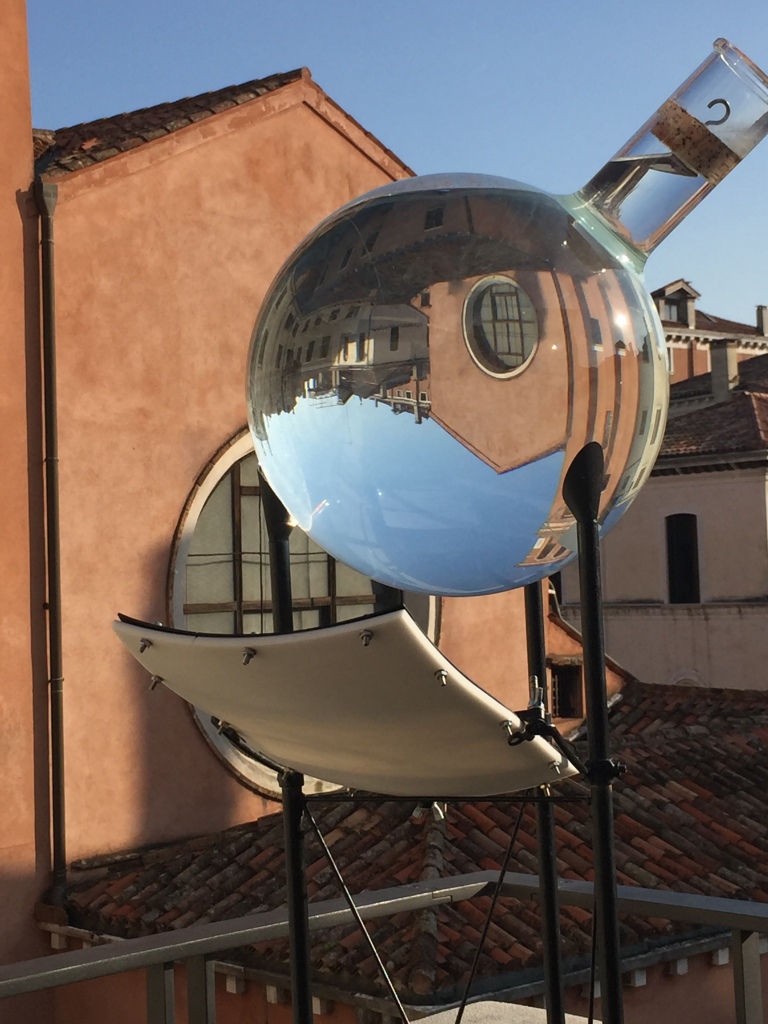
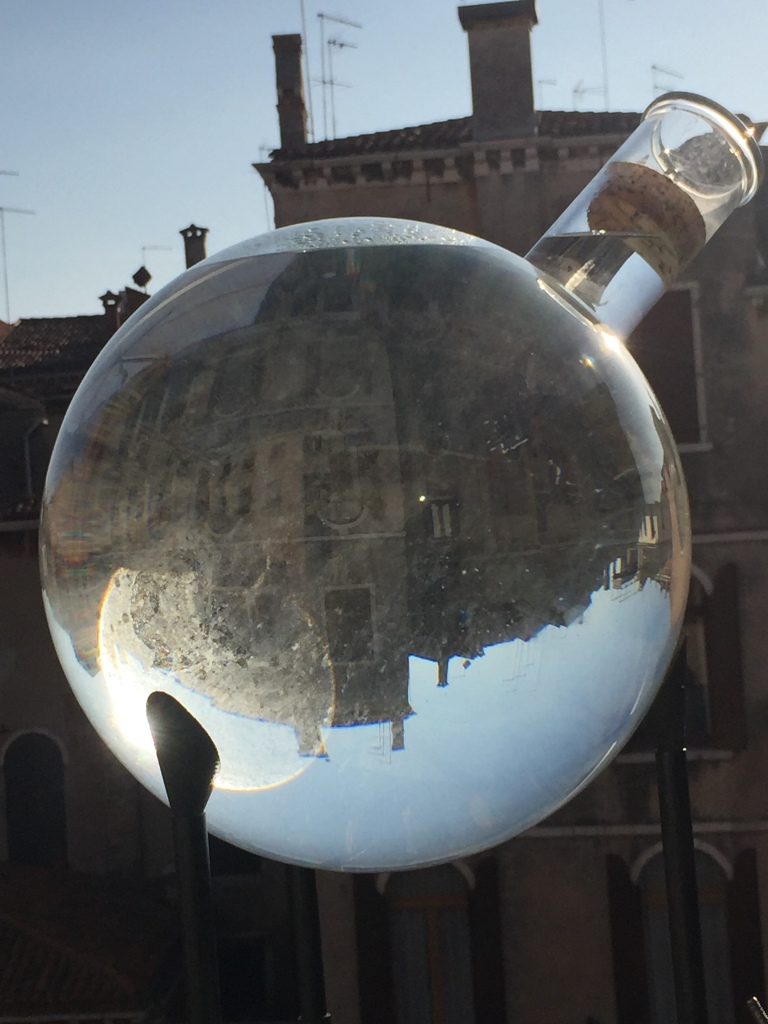
Daniel Pesta shows a video installation called, The Chain, where in a deserted dark and gloomy factory hall an imaginary secret society sits around a wooden table. One view their secret practice in awe! As the commentary on this work states, It is precisely at tables such as this that the fate of groups, individuals or nations is decided. So the work focus on secret societies, totalitarian conspiracies, religious or power groupings, and points out not only the aggressiveness of the “so-called” leaders, their superiority and manipulation, but bears witness also to the fear of those who are intrigued by narcissism.
Another video installation of Betty Susiarjo, A Dazzling Grey, 2019 was great to view. The work immediately but nature to the foreground and I was captivated by two videos playing simultaniously – one shows the graceful movement of birds, presented
and juxtaposed as references of two landscapes. The artists intention is that together, the videos become windows that frame instances of ordinary
encounters. Yet, this meditative act of gazing could also transport us
to a dream-like realm, filtering our conceived realities and fantasies.
What is seen as certain may not be after all, and what seems indefinite, could be authentic. The Asian landscape reminded me of a Van Gogh painting of cherry blossoms
Georg Baselitz Retrospective
This exhibition is in the Gallerie dell’ Accademia. Baselitz, a living German artist ( 80+years of age), whose 60-year oeuvre ( drawing, prints, paintings and sculpture) has always been about destabilising the image, most notoriously by turning it upside down is here with the classic paintings and sculptures of masters from the Renaissance. This gallery has on display masterpieces of Venetian paintings from Veneto as well, from the Bizantine and Gothic fourteenth century to the artists of the Renaissance, Bellini, Carpaccio, Giorgione, Veronese, Tintoretto and Tiziano until Gianbattista Tiepolo and the Vedutisti of the eighteenth century, Canaletto, Guardi, Bellotto, Longhi. These artists influenced the whole history of European painting, and I believe this is the idea behind this exhibition. I did not expect to find an Andy Warholl!
He is a Neo-Expressionist who rejected abstraction in favour of recognizable subject matter, deliberately employing a raw style of rendering and a heightened palette in order to convey direct emotion. He confronts the theme of painting not by reducing it to its essence but rather by attacking the convention itself, when in 1969 he began to paint and display his subjects upside down. In this way his intention was to slow down his process of painting as well as the viewer’s comprehension of the motif. His iconic paintings, depict inverted figures, landscapes, and still lifes, and achieve a form of abstraction while maintaining figuration. It seems that one should not miss the fact that he has a close relationship with Italy and the academic tradition, when he became pre occupied with Renaissance art during an art residency in Florance early in his career. Looking as his work and learning that he incorporated from many influences, including art of Soviet era illustration art, the Mannerist period and African sculptures, he developed his own, distinct artistic language, is important to me.



Dysfunctional
I loved the fact that comtemporary pieces are set within a gallery with a collection of great Renaissance and Baroque pieces – the murals of 1500 – 1564, with affresco staccato, particularly stole my attention, as well as a Van Ecyk Crucifixion. More than 50 modern works were on exhibition – installations were real show stoppers and site specific – fragile chandeliers, glass bubbles, furniture, etc. In the installation Real Time (2019), Maarten Baas shows himself in his atelier indicating time I read it was created specifically for this exhibition in Leonardo da Vinci’s homeland, exactly 500 years after he passed away, this work references the Vitruvian Man, while addressing the different aspects of passing time: getting older, moving forward and looking back. Recalling Venice as the epicentre of looking-glass manufacture once upon a time,
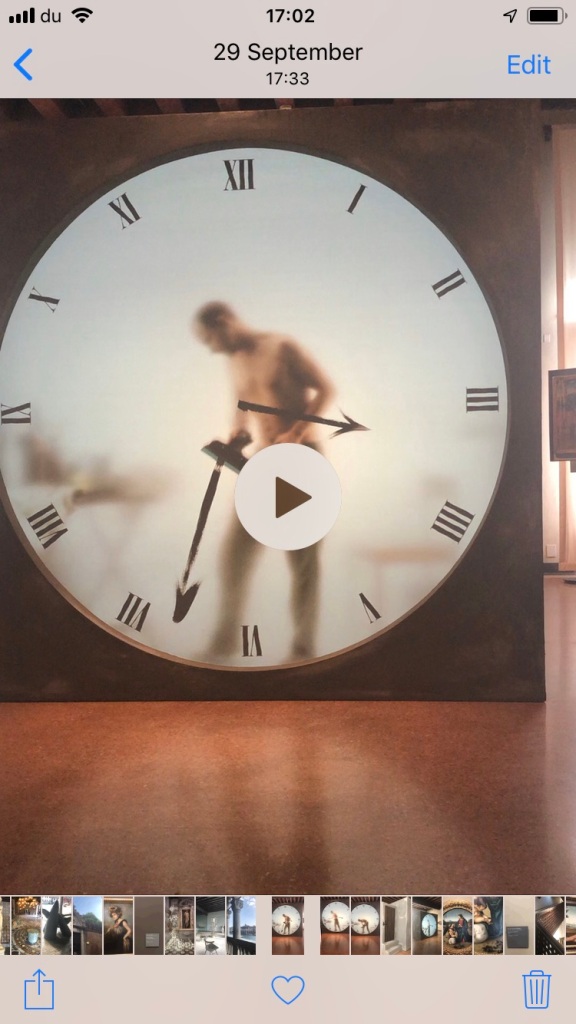
Adrian Ghenie
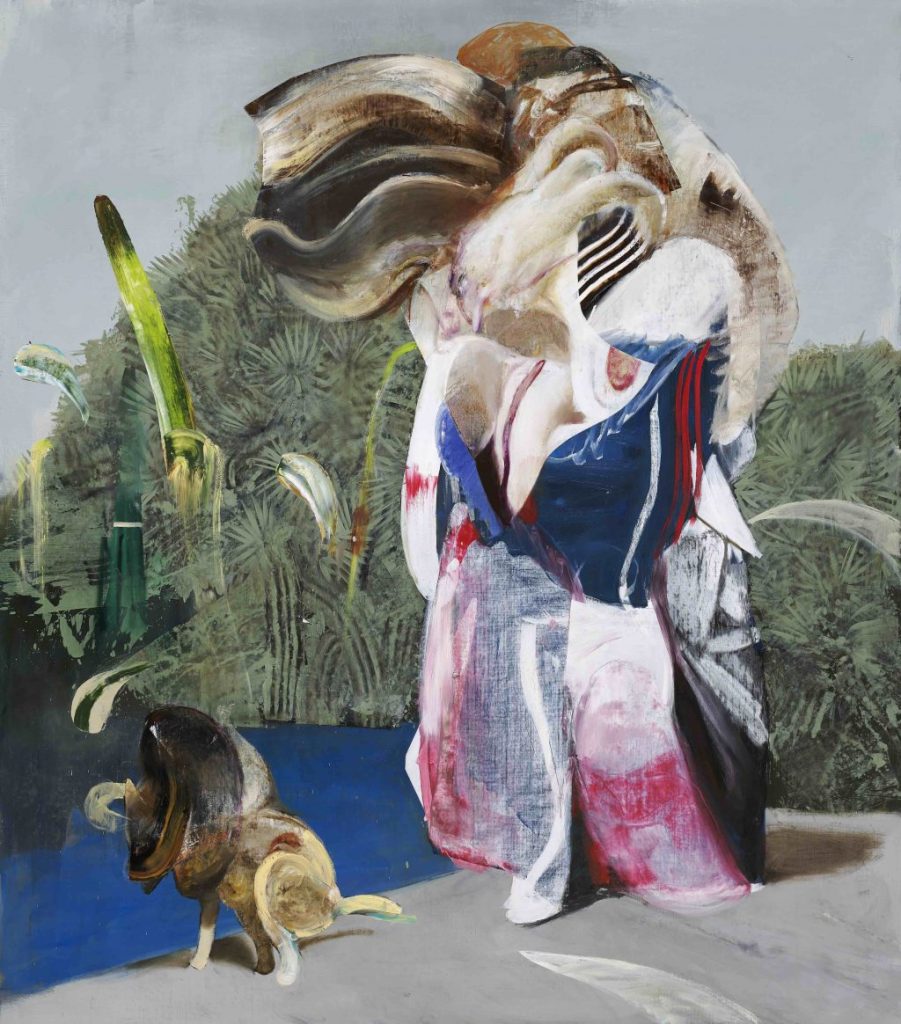
I wrote about the work in my learning blog and think that is sufficient.
Guatemala
The exhibition at the Pavilion of Guatemala investigates the pressing question of violence against women. I first encounter the work of the artist Marco Manzo – a video is playing showing his work practice. His installation consists of a monumental wall that incorporate masculine and feminine hands tattooed with symbols of machismo taken from Guatemalan culture. Then there is the work of Elsie Wunderlich, whose sculptures of woman’s faces bare the marks of violence against them. I read that her work is primarily inspired by the natural world and questions of human integration within it. Her serene works demonstrate a profound sensitivity to the natural world as she explores difficult questions facing women and humanity

The theme, ‘interesting state’ immediately strikes the collective imagination, with a mental association that refers to the woman who is pregnant, a veritable treasure chest of new life. On the contrary, the acts of violence against women constitute the denial of existence. Guatemala is an ‘interesting State’ precisely in this sense, because of the persistence of this devastating phenomenon and the government’s desire to remedy it. On their skin women bear wounds of unspeakable pain and humiliation, and they are silenced out of fear or shame. Art therefore becomes an ethical instrument, in which the seductive aesthetic nature of the works is there to serve an indispensable social denunciation and an essential opportunity for redemption. There is a big graphite drawing of the artist Paolo Rossetto which I particularly admired for its sheer size and detail drawing. In an accompanying document I read that this work can be seen as part of his studies on metamorphosis – a b=nymph going through this transformation in her body and brings one to the dialogue between man and nature. The tree is like Mother Nature with the profile of a woman and more heads spreading out in the branches I read the following artist statement about him: “His artistic language was mainly figurative, but it then gradually transformed into a style between surrealism and fantasy and he developed a very personal technique.”
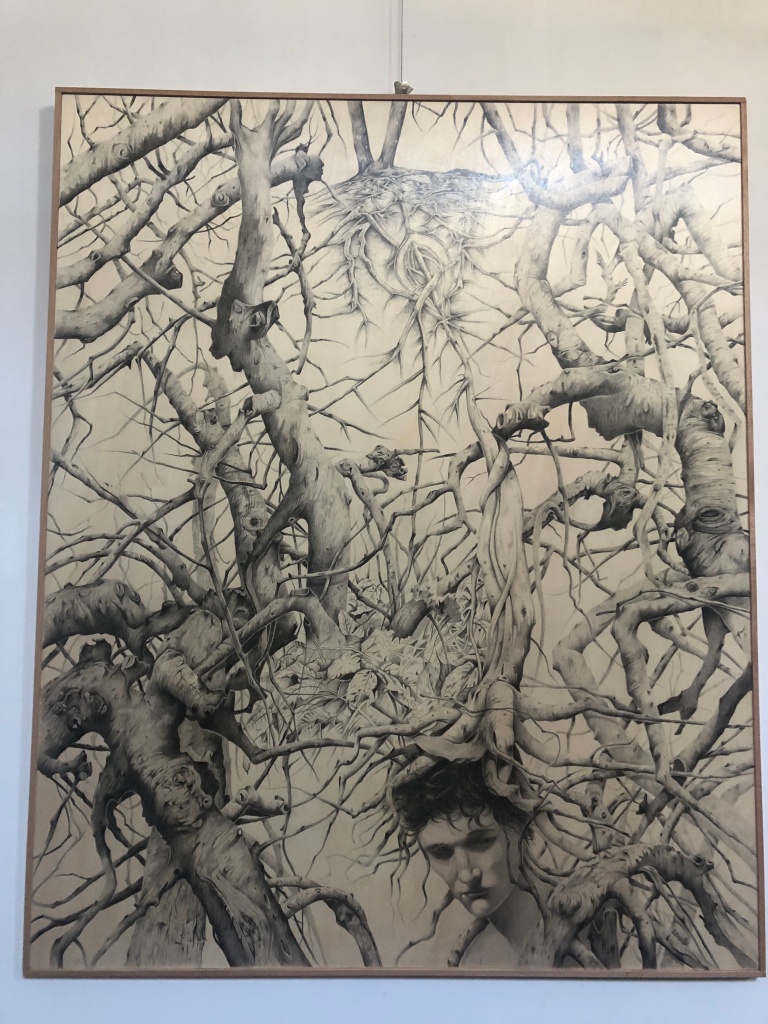
3x3x6 Shu Lea Cheang
This installions/videos/AI gave one an insight into digital surveillance technology and the power of social media. It was done by Taipei’s Fine Arts Museum of Taiwan. The idea to ‘3x3x6’ is that it is set in a 16th-century Venetian prison turned interactive installation centred around wrongful incarceration due to gender or sexual dissent. I learnt that Cassanova was also imprisoned here, but that he escaped, as well as that Michael Foucault was investigated by the Polish Police and incarcerated for an unknown period of time. I looked at this exhibition before I came on the internet, and have to admit that the actual experience was not up to my expectation. ( I did not participate in the invitation to send selfies before my visit) I felt it lost its spark.
Getting lost – Ca Rezzonico visit
This visit was very short, as I got lost from my companions, and accidentally followed a private tour – I realised my mistake and found my companions in the end. Did see a few great works (Veronese, Tintoretto, Cima da Conegliano, Fransesco Belancussi and Tiepolo) and lovely palazzo rooms. In their shop I found a small gift to take home – I did a study for a print in 2018 on the work of Pietro Detto Longhi , La Mostra del rinoceronte, 1751, and is part of my Contemplating Rhino blog – a postcard of the work as well as a bookmark is just apt. ( blog access: http://contemplatingrhino.com)


Comments and thoughts at this stage
Art has the ability to share and contemplate/reflect on many ideas, truths and visual information. We live in a time where so much about ourselves have become collected information which can influence and control our social connectedness, lifestyle, health and choices. It makes me want to stand still for a moment and ask myself about how I value privacy and respect for humanity in this challenging times we live in.
I am confronted by the way the world battles to communicate with each other – politically, economically, culturally. Art should never allow that information be channeled into narrowing these communication channels. We should open up, innovate, create constantly in order to always find new ways of understanding, listening, sharing, learning and some meaningful contemplation. For myself the learning is to explore different methods of working – develop and explore my ideas.